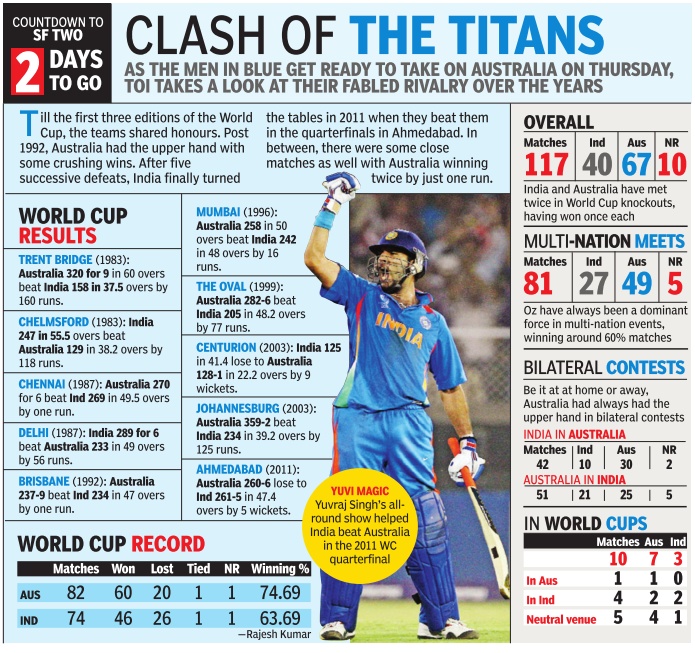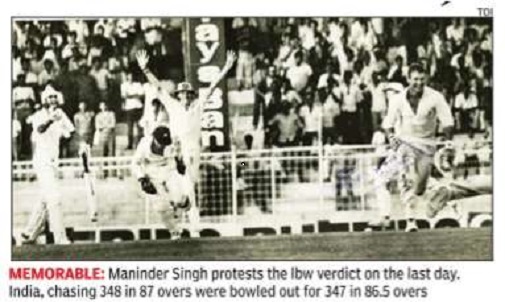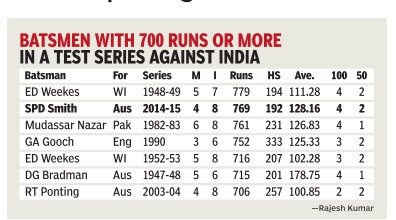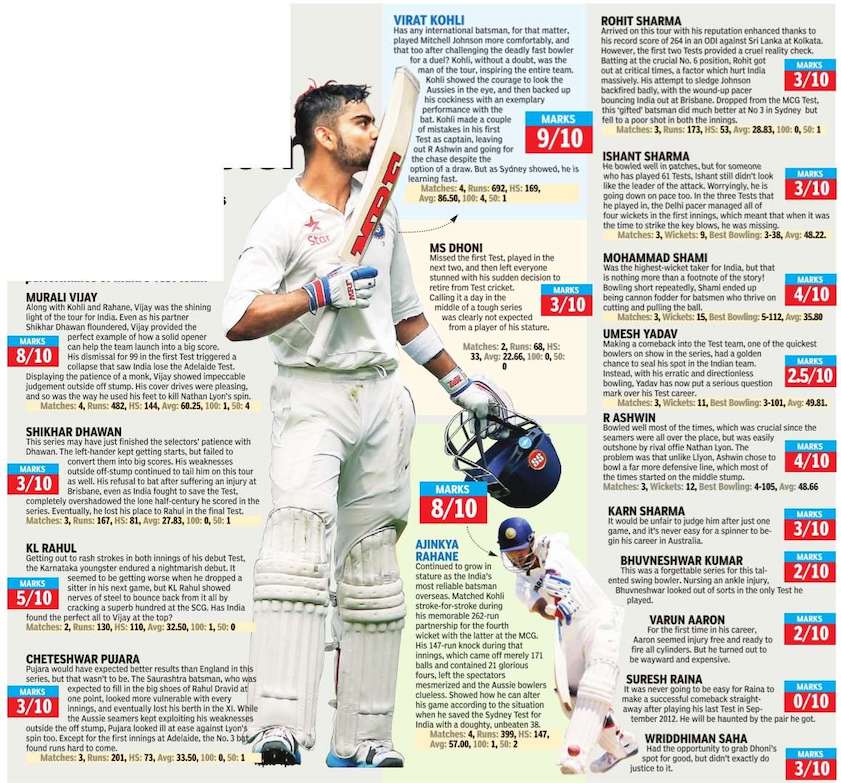Australia vs. India, cricket
(→1991-92 tour) |
|||
| Line 11: | Line 11: | ||
[[Category:Australia |C ]] | [[Category:Australia |C ]] | ||
[[Category:Cricket |A ]] | [[Category:Cricket |A ]] | ||
| + | |||
| + | =1969= | ||
| + | ==Test match in Delhi== | ||
| + | [https://epaper.timesgroup.com/Olive/ODN/TimesOfIndia/shared/ShowArticle.aspx?doc=TOIDEL%2F2018%2F01%2F28&entity=Ar02712&sk=4580C8AA&mode=text SUNIL GAVASKAR, On Day 4, fears of Kotla, 1969 when pitch started behaving, January 28, 2018: The Times of India] | ||
| + | |||
| + | The last time one heard of a dramatic improvement in the condition of a pitch was way back in 1969, when Australia toured India under Bill Lawry. That was the Test match at the Ferozeshah Kotla in Delhi and India, after having bowled Australia for a low score in the second innings, were left to chase 190-odd in the fourth innings. | ||
| + | |||
| + | The Indian spinners had turned the ball considerably and with the guile — added to their natural talent — had made Australia’s batsmen look pretty ordinary. Australia had Ashley Mallet and John Gleason in their ranks and so had the spin component along with the pace of Graham Mc-Kenzie, Alan Connolly to make India’s run chase tough if not impossible. | ||
| + | |||
| + | What happened was quite incredible as India coasted to an easy win, losing only three wickets in the bargain. Mallet hardly got to turn the ball and India’s batsmen being good players of spin were not going to fail if the ball wasn’t turning. The morning session on the fourth day at the Wanderers reminded of that Delhi game as the pitch, which had been the subject of much discussion the previous day, had seemingly gone to sleep. | ||
| + | |||
| + | The ball hardly jumped up awkwardly and while it went past the outside edge quite regularly, India failed to get a single wicket in the pre-lunch session. Both Amla and Elgar batted with great gumption and determination and ran very well between the wickets to keep the strike moving, making it difficult for the bowlers to bowl to the right and left-hand combination. | ||
| + | |||
| + | Amla got a half century in each innings on this pitch, which is a terrific achievement and tells you how underrated a player he is. Elgar has always been a fighter and a gritty player batting well within his limitations. The wickets of de Villiers and Amla, however, was just the tonic that India needed and it paved the way for a famous win. PMG/ESP | ||
=India’s high-five down under: 1977-2008= | =India’s high-five down under: 1977-2008= | ||
Revision as of 20:58, 31 January 2018

This is a collection of articles archived for the excellence of their content. |
Contents |
1969
Test match in Delhi
The last time one heard of a dramatic improvement in the condition of a pitch was way back in 1969, when Australia toured India under Bill Lawry. That was the Test match at the Ferozeshah Kotla in Delhi and India, after having bowled Australia for a low score in the second innings, were left to chase 190-odd in the fourth innings.
The Indian spinners had turned the ball considerably and with the guile — added to their natural talent — had made Australia’s batsmen look pretty ordinary. Australia had Ashley Mallet and John Gleason in their ranks and so had the spin component along with the pace of Graham Mc-Kenzie, Alan Connolly to make India’s run chase tough if not impossible.
What happened was quite incredible as India coasted to an easy win, losing only three wickets in the bargain. Mallet hardly got to turn the ball and India’s batsmen being good players of spin were not going to fail if the ball wasn’t turning. The morning session on the fourth day at the Wanderers reminded of that Delhi game as the pitch, which had been the subject of much discussion the previous day, had seemingly gone to sleep.
The ball hardly jumped up awkwardly and while it went past the outside edge quite regularly, India failed to get a single wicket in the pre-lunch session. Both Amla and Elgar batted with great gumption and determination and ran very well between the wickets to keep the strike moving, making it difficult for the bowlers to bowl to the right and left-hand combination.
Amla got a half century in each innings on this pitch, which is a terrific achievement and tells you how underrated a player he is. Elgar has always been a fighter and a gritty player batting well within his limitations. The wickets of de Villiers and Amla, however, was just the tonic that India needed and it paved the way for a famous win. PMG/ESP
India’s high-five down under: 1977-2008
[ From the archives of the Times of India]
Fast and bouncy wickets, quality opposition and general tendency to underperform abroad have been key factors for India having never won a series in Australia since 1947-48, their first tour Down Under. However, they have recorded five Test wins which rank among their best triumphs. We take a look at those cherished wins...
ADELAIDE, 2003-04
Thanks to a fighting hundred by Sourav Ganguly at Brisbane, India had begun with a bang. At Adelaide, Australia scored 398 for five on Day 1. The Kangaroos finished at 556, with Ricky Ponting getting 242. Buoyed by Rahul Dravid’s 233 and VVS Laxman’s 148, India replied strongly with 523. Dravid and Laxman again tormented the Aussies by batting together a whole day. Australia suffered a shocking collapse in the second innings, with seamer Ajit Agarkar taking 6-41. Dravid anchored a tense chase beautifully with an unbeaten 72 as India recorded a welldeserved win.
MCG, 1977-78
Playing against an Australian team missing all the top stars due to the ‘Packer revolution’, India were staring down the barrel after being 0-2 down, having lost the Tests in Adelaide and Perth. The Aussies were being led by Bobby Simpson, who had been dragged out of retirement. The visitors, however, turned it all around magnificently at the MCG, recording their first Test win Down Under. The stars for India were legendary opener Sunil Gavaskar, who scored 118 in the second innings, and leggie Bhagwat Chandrashekhar, who took six wickets in each innings to leave the Aussies bamboozled. SCG, 1977-78: Having smelt blood, India were on a roll and decimated Australia by an innings and two runs in the game at Sydney, a venue which favoured their traditional strength — spin. Chandrashekhar, Bishan Bedi and Erapalli Prasanna left the Aussies in a ‘spin’. Australia could manage just 131 in the first innings. India replied with 396 for eight declared and sealed the game. Gavaskar, who hit three hundreds in that series, added 97 for the first wicket with Chetan Chauhan. Gundappa Viswanath top-scored with 79, Dilip Vengsarkar got 48, but the real surprise package was seamer Karsan Ghavri, who went on to make 64. Australia fought hard in the second essay, but the Indian spinners were not to be denied their glory.
MCG, 1981
This can safely be labelled as ‘Kapil’s Test’. Bowling with a torn hamstring, Kapil took five for 28 to earn India a 59-run victory. This game had plenty of memorable action. Gavaskar, after a spat with Dennis Lille, threatened to take fellow opener Chetan Chauhan off the field and concede the Test. It would have been a diplomatic disaster had it not been for the timely intervention of wing commander Durrani, who was the manager on that tour. Interestingly, Ghavri got Greg Chappell in both the innings, the second time for a blob.
PERTH, 2007-08
Arguably India’s greatest overseas triumph. On the bounciest wicket in the world, India went into the game in the worst possible frame of mind. They had lost two Tests already, and worse, were hounded by the ‘Monkeygate’ scandal that threatened the tour altogether. Pleasantly surprising everyone, India put all controversies behind to beat Australia. Ishant Sharma got Ponting out after delivering a spell the Aussie great himself later termed as the “best” he had faced all his life. Irfan Pathan took five wickets and scored 46 to win the Man of the Match award while Rahul Dravid scored a crucial 93. Australia were left stunned after the loss and many former players demanded an inquest into why the home team’s pacers didn’t swing the ball much. The Aussies were also accused of lacking aggression after the happenings in Sydney. For India, a win seemed like poetic justice.
1986: Tied test, Maninder’s questionable dismissal
On September 22, Thursday, it will be 30 years since the second-ever tied Test match ended at the MA Chidambaram stadium. The leg-before dismissal of Maninder Singh off Australian spinner Greg Matthews in the second last ball of the final over, to date, haunts many Indians.
But the man who delivered the verdict -umpire V Vikramraju -prefers to remember the game for the quality of cricket rather than the controversy which erupted following his decision which many players thought was contentious.
On Monday, as the affable 82year-old regaled fellow umpires with stories from the `good old days', the Chennai Test was the highlight. He was even felicitated by umpires in Hubballi to mark the 30th anniversary of the epic Test. Later, speaking to TOI, Vikramraju said, “It was a great match and one I will remember forever.
“It was a landmark match for many players. Sunil Gavaskar was playing his 100th Test, Dean Jones scored a double century and there were three other centurions. If you are asking me about the last-wicket decision, then like I have always said through these three decades, I stand by it. Maninder's bat did not come in contact with the ball. It was a clear LBW. Everybody including my fellow umpire Dara N Dotiwalla agreed that the decision was right.“
The Bengaluru umpire also dismissed claims by former players, who played the match, that they had a chat with him after the game ended.
“None of the players came up to me or told me anything after the match. The first time I heard murmurs of displeasure from the Indian players was when Ravi Shastri spoke about it a few days later. It didn't matter because the match was over.“
The match was also Vikramraju's second and last as a Test umpire. Does he think that decision changed the course of his career?
“I don't know. I never dwelled too much on it. I was 52 then and had three more years according to the age norms for international umpiring. A Test never came my way but I continued to do domestic matches including Ranji Trophy final and ODIs. I have no regrets in my career„“ he said.
1991-92 tour

2001
India wins at Eden Gardens
Mar 15, 2017: The Times of India
On this day: Test cricket turns 140 & India seal an epic victory at Eden Gardens in 2001
NEW DELHI: This match is the stuff of legend and the outcome could not have come on a better day than March 15, the 124th anniversary of the first ever official Test match. India down 0-1 in 2000-01 three-match Test series, bowled out for 171 in reply to Australia's 445 in the second Test, forced to follow on ... and then it all turned very, very special.
The hero for India was VVS Laxman, whose 83-ball 59 from No. 6 inspired the move to send him in at No. 3 when India batted a second time on the third day.
Laxman finished the day not out on 109 and with Rahul Dravid (180) batted the entire fourth day while adding 335; the eventual stand of 376 broke a series of records and took India to 589 for 4.
Laxman batted his way to a marathon 281, the highest Test score by an Indian and one that changed the tone of the match. Sourav Ganguly's declaration with a lead of 383 set Australia 75 overs to bat out a draw; Harbhajan Singh n whose first-innings 7 for 123 on day one included the first hat-trick by an Indian in Tests had other ideas and took six wickets to bowl India to an epic win. 16 years on, the victory is still afresh in minds of those who witnessed the Eden miracle and cricket lovers across the globe.
Today also marks the 140th anniversary of the first ever official Test match that was played between England and Australia at the MCG in 1877. Google dedicated a Doodle to celebrate anniversary. The first official cricket Test match in history began on this day in 1877 between an established English team and a newly-formed Australian squad at the Melbourne Cricket ground. It finished in a 45-run win for Australia.
"Today's Doodle hits the deck with a light-hearted rendering that captures the spirit of sportsmanship and the inaugural Test match," Google said. "Mustachioed and muscle-bound, the batsmen, bowlers and opposition fielders spring into action, never losing sight of the red ball," it said.
TIMES IN AUSTRALIA - DOWN AND OUT
Jan 10 2015,
Partha Bhaduri, The Times of India
It took willful intent from both sides to bring this game momentarily alive. After three and a half days of meandering cricket on the flattest of surfaces, including the rare offering of a wagging Indian tail, there finally followed a contest brief between bat and ball at the SCG. Then Joe Burns arrived and smashed India's hopes out of sight, allowing Australia to gallop to a 348-run lead at stumps. It was a mad scramble for ascension and Australia came out on top on the day. Unlike the dark clouds and prospect of thundershowers looming over the city, the entertainment in the middle was a welcome change after the tedium of the past few days.
Sixes rained, wickets fell, and Ravichandran Ashwin (50 runs; 4105) had his say. It was not enough, however, to make any significant difference to his side, even though the pitch mercifully deigned to offer disconcerting turn and variable bounce.
The series won, the Aussies, already 97 ahead after India closed shop at 475, were in attacking mode, looking to dangle the carrot of a 300-plus target for India on the last day . Kohli, all passion and positive energy and seeking a way for India to claw back into the game after his early dismissal in the morning, believed there yet could be a twist in the tale.
But Australia scored at 6.27 per over throughout their 40 overs, the last 10 of those going for more than eight runs each as Burns blazed to a 33-ball half-century . Amid the carnage were the old constants: Smith and Rogers again scored half centuries, and Umesh Yadav obligingly sprayed the ball.
Dramatic scenes followed as Virat Kohli decided to throw the new ball to Ashwin in the second over of Australia's innings. Warner fell edging to first slip, playing back to a length ball and the spin and bounce doing the rest. Watson under-edged one on to his stumps.
Five Australian wickets fell before bad light dominated, three of them to Ashwin, but it was Australia which ticked all the boxes: Smith scored 70 from 71 balls, going past Don Bradman as the highest scorer in all India-Australia series. Anything overpitched or marginally short was punished, a lot of runs coming behind square.Ashwin was reverse swept and tonked over cover for maximum.Yadav , either short or wide or stray ing down leg, was pulled and swatted away on the on-side as four boundaries came off the seamer's first over. Only the late inswing from Shami prevented further damage. Rogers too flung his bat around and brought up his sixth consecutive half-century .
A chastened Kohli spread the field, and it was not until he had the courage to crowd men around the bat again that Shaun Marsh fell. The Indians, however, had not accounted for Burns, who batted on this turning pitch as if it was the Gabba of his teenaged days, adding 86 with Haddin to probably take it beyond India's means: The highest successful chase at the SCG is only 288.
Burns took on India's best bowler, Ashwin, tonking him for three sixes, and hit four consecutive fours off Yadav late in the day, gliding to third man, flicking and pulling and generally making a mockery of the attack. Kohli could only give three overs to Yadav, but those yielded 45 runs.Now-regular wicketkeeper Wriddhiman Saha was twice a victim of nerves, botching up a run-out chance and missing a stumping to give Burns a reprieve.
Earlier, Ashwin and a resolute Bhuvneshwar Kumar helped the last four wickets add 123 runs as India hung around batting as much time as they could, but with the pitch playing tricks, will it be enough to see them through? Kohli, for one, will be looking to give the Aussies at least some anxious moments.
2014- 15: Individual performances
Jan 12 2015
While the likes of Kohli, Vijay and Rahane came out with flying colours during the Test series against Australia, a few other batsmen, and almost all the bowlers, were found wanting. Gaurav Gupta rates the performance of India's Test team.


